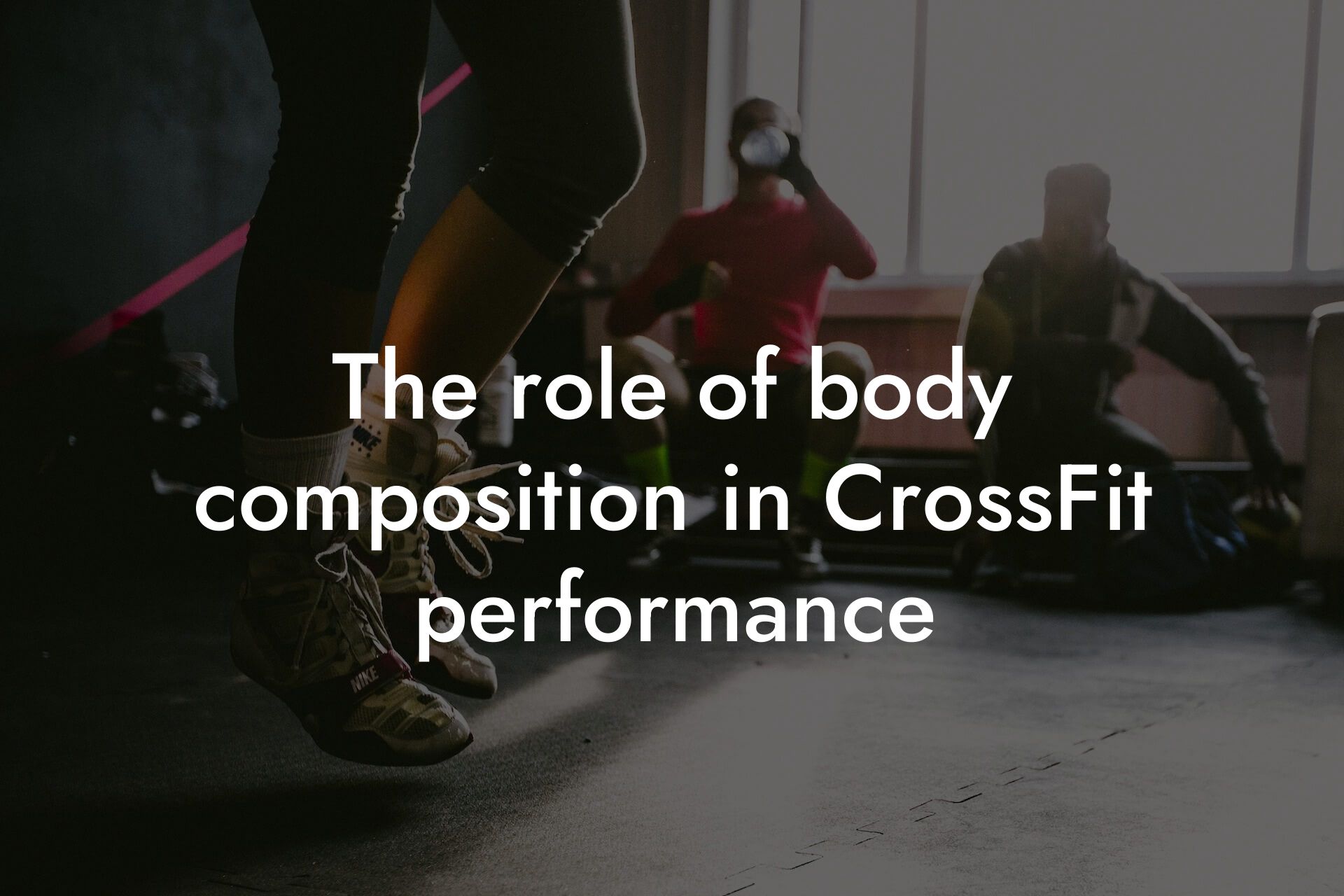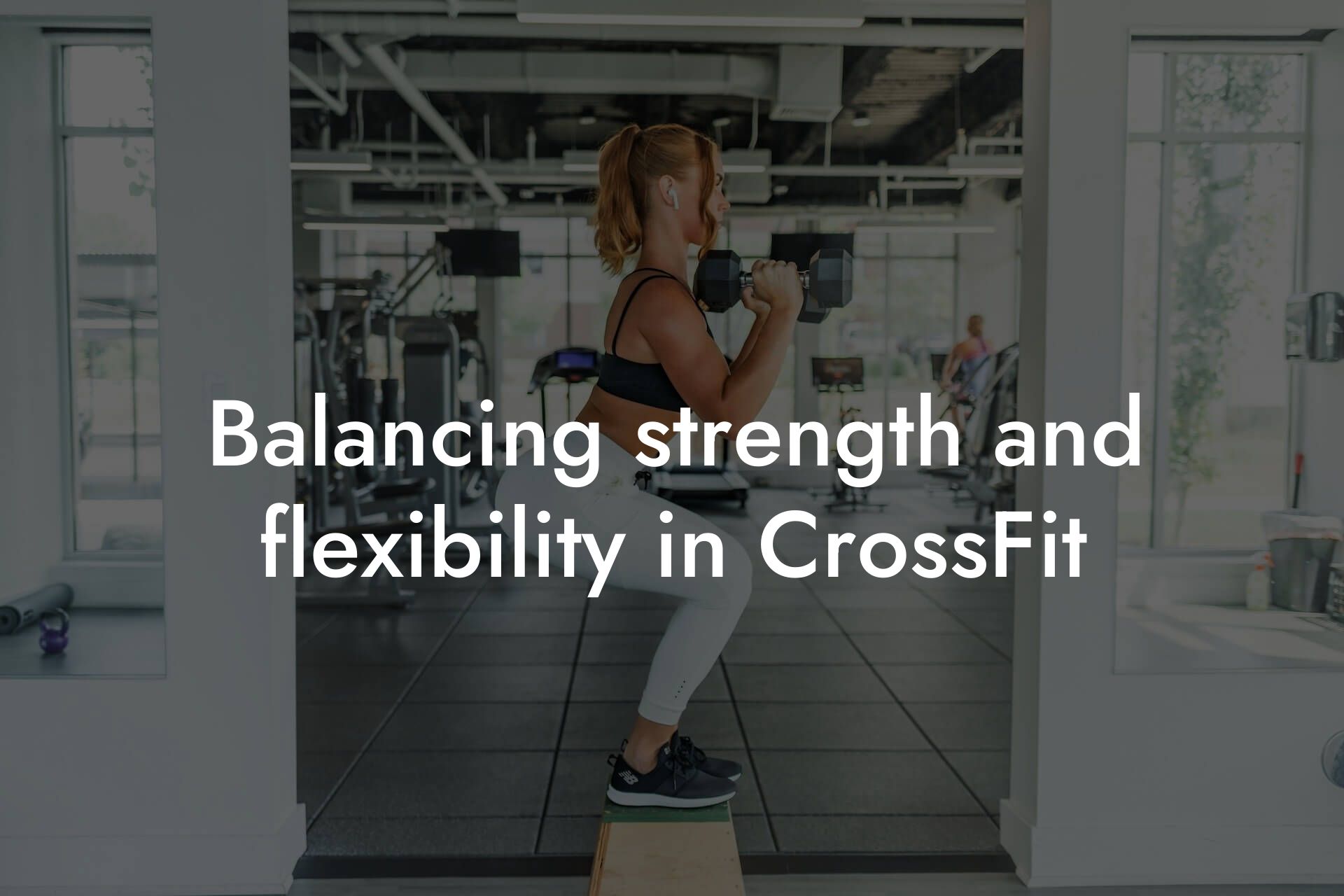As a high-earning professional, you understand the importance of taking care of your physical appearance and overall health. CrossFit is an excellent way to improve your physique, increase bone density, and boost your confidence. However, it's equally important to prioritize muscle recovery to avoid injuries, optimize performance, and achieve your fitness goals.
Table of Contents
What is Muscle Recovery?
Muscle recovery refers to the process of repairing and rebuilding muscle tissue after intense physical activity. When you engage in high-intensity exercises like CrossFit, your muscles undergo micro-tears, leading to inflammation and muscle soreness. Adequate recovery allows your muscles to repair and adapt, making them stronger and more resilient over time.
Why is Muscle Recovery Crucial in CrossFit?
CrossFit workouts are designed to push your body to its limits, often leaving you feeling exhausted and sore. Without proper recovery, you may experience decreased performance, increased risk of injury, and prolonged muscle soreness. In fact, research suggests that inadequate recovery can lead to overtraining syndrome, characterized by fatigue, insomnia, and decreased motivation.
The Consequences of Poor Muscle Recovery
Ignoring muscle recovery can have serious consequences, including:
- Increased risk of injury: Fatigued muscles are more prone to strains, tears, and other injuries.
- Decreased performance: Poor recovery can lead to decreased strength, power, and endurance, making it difficult to achieve your fitness goals.
- Prolonged muscle soreness: Insufficient recovery can prolong muscle soreness, making it uncomfortable to perform daily activities.
- Overtraining syndrome: Chronic fatigue, insomnia, and decreased motivation can result from inadequate recovery.
Benefits of Proper Muscle Recovery
On the other hand, prioritizing muscle recovery can bring numerous benefits, including:
- Improved performance: Adequate recovery allows your muscles to repair and adapt, leading to increased strength, power, and endurance.
- Reduced risk of injury: Proper recovery helps to reduce muscle fatigue, making you less prone to injuries.
- Enhanced muscle growth: Adequate recovery provides your muscles with the necessary time to repair and grow, leading to increased muscle mass.
- Better overall health: Muscle recovery is essential for maintaining overall health, as it helps to reduce chronic inflammation and improve immune function.
Strategies for Effective Muscle Recovery
Fortunately, there are several strategies you can implement to optimize muscle recovery, including:
- Stretching and foam rolling: Gentle stretching and foam rolling can help to reduce muscle tension and promote blood flow.
- Rest and recovery days: Incorporating regular rest and recovery days into your training program can help to reduce muscle fatigue and promote recovery.
- Nutrition and supplementation: Consuming a balanced diet rich in protein, complex carbohydrates, and healthy fats, as well as incorporating recovery supplements like protein powder and creatine, can help to support muscle recovery.
- Sleep and relaxation: Prioritizing adequate sleep and engaging in relaxation techniques like meditation and deep breathing can help to reduce stress and promote recovery.
- Compression garments and massage: Wearing compression garments and incorporating regular massage can help to improve blood flow and reduce muscle soreness.
The Role of DEXA Scans in Muscle Recovery
At Tano Performance Group, we understand the importance of muscle recovery in achieving your fitness goals. That's why we offer DEXA scans, a comprehensive body assessment tool that provides valuable insights into your body composition, bone density, and muscle mass. By tracking your progress and identifying areas for improvement, you can optimize your training program and recovery strategies to achieve optimal results.
In conclusion, muscle recovery is a critical component of any CrossFit training program. By prioritizing recovery, you can reduce your risk of injury, optimize performance, and achieve your fitness goals. Remember to incorporate stretching, rest and recovery days, nutrition, sleep, and relaxation into your training program, and consider utilizing DEXA scans to track your progress and optimize your recovery strategies. With the right approach, you can take your fitness to the next level and achieve the physique you've always desired.
Final Thoughts
As a high-earning professional, you understand the importance of investing in your health and wellbeing. By prioritizing muscle recovery and incorporating the strategies outlined above, you can optimize your performance, reduce your risk of injury, and achieve your fitness goals. Remember, recovery is not a luxury, it's a necessity. Make it a priority, and you'll be on your way to achieving the physique and performance you've always desired.
Frequently Asked Questions
What is muscle recovery, and why is it crucial in CrossFit?
Muscle recovery refers to the process of repairing and rebuilding muscle tissue after intense physical activity, such as CrossFit. It's essential because it allows your muscles to adapt to the demands of exercise, rebuild strength, and prevent injury. Without proper recovery, you may experience fatigue, decreased performance, and increased risk of injury.
How does CrossFit differ from other forms of exercise in terms of muscle recovery?
CrossFit is a high-intensity, high-volume form of exercise that involves a variety of movements, weights, and cardio exercises. This unique combination can lead to increased muscle damage and inflammation, making recovery even more critical. Additionally, CrossFit's emphasis on functional movements and explosive power output can put additional stress on muscles and joints, further highlighting the need for effective recovery strategies.
What are the consequences of neglecting muscle recovery in CrossFit?
Neglecting muscle recovery can lead to a range of negative consequences, including decreased performance, increased risk of injury, chronic fatigue, and prolonged muscle soreness. This can ultimately impact your ability to reach your fitness goals, maintain consistency, and enjoy the activities you love.
What are the key components of an effective muscle recovery strategy in CrossFit?
A comprehensive muscle recovery strategy should include a combination of proper nutrition, adequate sleep, stretching and foam rolling, compression garments, and active recovery techniques such as light cardio or yoga. Additionally, incorporating recovery tools like NormaTec boots, cryotherapy, or electrical muscle stimulation can also be beneficial.
How does nutrition play a role in muscle recovery?
Nutrition is a critical component of muscle recovery, as it provides the necessary building blocks for repair and rebuilding. A balanced diet that includes adequate protein, complex carbohydrates, and healthy fats can help promote muscle recovery. Additionally, strategic supplementation with protein shakes, creatine, and branched-chain amino acids (BCAAs) can also support recovery.
What is the optimal amount of sleep for muscle recovery in CrossFit?
Aim for 7-9 hours of sleep each night to support muscle recovery. During sleep, your body repairs and rebuilds muscle tissue, consolidates muscle memory, and replenishes energy stores. Adequate sleep is essential for physical adaptation and recovery.
How can stretching and foam rolling aid in muscle recovery?
Stretching and foam rolling can help reduce muscle tension, improve circulation, and promote relaxation. This can aid in reducing muscle soreness, improving range of motion, and enhancing overall recovery. Focus on static stretches that hold the muscle in a lengthened position for 20-30 seconds, and use foam rolling to target specific areas of tension.
What is the role of compression garments in muscle recovery?
Compression garments, such as tights or sleeves, can help improve circulation, reduce muscle oscillation, and provide support to the affected area. This can aid in reducing muscle soreness, improving recovery, and enhancing overall performance.
How can active recovery techniques, like yoga or light cardio, support muscle recovery?
Active recovery techniques can help promote blood flow, reduce muscle tension, and enhance relaxation. This can aid in reducing muscle soreness, improving recovery, and preparing the body for future exercise. Focus on low-intensity activities that promote gentle movement and relaxation.
What are NormaTec boots, and how do they aid in muscle recovery?
NormaTec boots are compression boots that use dynamic compression to improve circulation, reduce muscle soreness, and enhance recovery. They work by compressing the legs in a sequential manner, mimicking the natural muscle pump of the legs. This can aid in reducing muscle soreness, improving recovery, and enhancing overall performance.
How does cryotherapy support muscle recovery?
Cryotherapy, or ice baths, can help reduce inflammation, muscle spasms, and muscle soreness. This can aid in enhancing recovery, reducing muscle damage, and improving overall performance. However, it's essential to use cryotherapy judiciously, as excessive use can have negative effects on muscle function.
What is electrical muscle stimulation, and how does it aid in muscle recovery?
Electrical muscle stimulation (EMS) is a technique that uses electrical impulses to stimulate muscle contractions. This can aid in promoting muscle recovery, reducing muscle soreness, and enhancing muscle function. EMS can be particularly useful for individuals who are experiencing muscle fatigue or delayed onset muscle soreness (DOMS).
How often should I incorporate recovery techniques into my CrossFit routine?
Aim to incorporate recovery techniques 2-3 times per week, or as needed based on your individual training schedule and needs. It's essential to balance recovery with training to ensure optimal performance and adaptation.
Can I use recovery techniques during competition or intense training phases?
Yes, recovery techniques can be used during competition or intense training phases to aid in recovery and improve performance. However, it's essential to prioritize recovery techniques that are gentle and non-invasive, as excessive recovery techniques can interfere with training and competition.
How can I monitor my recovery and adjust my strategy as needed?
Monitor your recovery by tracking metrics such as heart rate variability, sleep quality, and muscle soreness. Adjust your recovery strategy based on your individual needs and response to training. Be willing to experiment and adapt your recovery strategy as needed to optimize performance and recovery.
What are some common mistakes people make when it comes to muscle recovery in CrossFit?
Common mistakes include neglecting recovery, overrelying on a single recovery technique, and failing to adapt recovery strategies based on individual needs. Additionally, inadequate nutrition, insufficient sleep, and poor training programming can also hinder recovery.
How can I prioritize muscle recovery in my busy schedule?
Prioritize muscle recovery by scheduling recovery sessions into your daily routine, just as you would schedule training sessions. Make recovery a non-negotiable part of your training program, and be willing to adapt your schedule as needed to ensure adequate recovery time.
What are some recovery techniques that can be done at home or on the go?
Techniques such as foam rolling, stretching, and self-myofascial release can be done at home or on the go. Additionally, portable recovery tools like compression sleeves and NormaTec boots can be used anywhere, making it easy to prioritize recovery even with a busy schedule.
How can I incorporate recovery into my daily routine, even on non-training days?
Incorporate recovery into your daily routine by prioritizing sleep, nutrition, and gentle movement. Engage in activities like yoga, walking, or light stretching to promote relaxation and recovery. Make recovery a habitual part of your daily routine, even on non-training days.
What are some common myths about muscle recovery in CrossFit?
Common myths include the idea that recovery is only necessary for elite athletes, that more is always better when it comes to recovery, and that recovery is a one-size-fits-all approach. In reality, recovery is essential for all athletes, regardless of level, and individualized approaches are often most effective.
How can I educate myself further on muscle recovery and its importance in CrossFit?
Continuously educate yourself through online resources, books, and workshops. Follow reputable sources and experts in the field, and stay up-to-date on the latest research and trends in muscle recovery. Prioritize learning and self-education to optimize your recovery and performance.
What are some resources or tools that can help me prioritize muscle recovery in CrossFit?
Resources include online articles, books, and workshops, as well as recovery tools like NormaTec boots, compression garments, and foam rollers. Additionally, working with a qualified coach or trainer can help you develop a personalized recovery strategy tailored to your individual needs.
Here are some related articles you might love...
- The role of body composition in CrossFit performance
- Nutrition strategies for CrossFit athletes
- Balancing strength and flexibility in CrossFit
- How DEXA scans can benefit CrossFit enthusiasts
- How to maintain bone density with CrossFit training
- Improving endurance for CrossFit competitions
- Strength training tips specific to CrossFit workouts
- Preventing injuries in CrossFit: A comprehensive guide
- Reducing body fat for better CrossFit performance
Zak Faulkner
Zak Faulkner is a leading authority in the realm of physical health and body composition analysis, with over 15 years of experience helping professionals optimise their fitness and well-being. As one the experts behind Tano Performance Group, Zak has dedicated his career to providing in-depth, science-backed insights that empower clients to elevate their physical performance and overall health.
With extensive knowledge of DEXA technology, Zak specializes in delivering comprehensive body assessments that offer precise data on body fat, muscle mass, bone density, and overall physique. His expertise enables individuals to make informed decisions and achieve their fitness goals with accuracy and confidence. Zak’s approach is rooted in a deep understanding of human physiology, combined with a passion for helping clients unlock their full potential through personalised strategies.
Over the years, Zak has earned a reputation for his commitment to excellence, precision, and client-focused service. His guidance is trusted by top professionals who demand the best when it comes to their health. Whether advising on fitness programs, nutritional strategies, or long-term wellness plans, Zak Faulkner’s insights are a valuable resource for anyone serious about taking their health and fitness to the next level.
At Tano Performance Group, Zak continues to lead our Content Team revolutionising how professionals approach their physical health, offering unparalleled expertise that drives real results.




